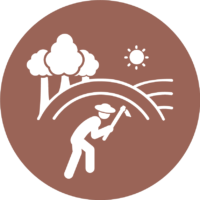Introducing Communally Owned and Managed Reserves Enabled Smallholders to Restore Cloud Forests
Wilson, S.J.. 2016. Communal management as a strategy for restoring cloud forest landscapes in Andean Ecuador. World development perspectives. Vol. 3: 47-49
It’s after sunset and getting dark fast. The electricity is out—again—so a single candle casts a small pool of light on my survey papers. Chickens peck around my feet in the dirt-floor kitchen. Wood smoke and wafts of dinner fill the cool Andean air. Up since 5 a.m. surveying trees and interviewing farmers, I’m less focused on the quaint scene than on finishing my last survey and starting my three-mile walk home in the dark. But my interviewee is holding fast on a subject dear to him.
“Why plant trees?” He’s standing now, gesturing emphatically. “Because they give us WATER!”
This man loves trees. And in Intag, a rural Andean community in northwest Ecuador, he’s not the only one.
A generation ago, the landscape here was covered in dense cloud forest. One of the most biodiverse ecosystems on the planet, cloud forests play their vital role in the hydrological cycle uniquely, capturing water from passing clouds and mist. After clearing 90% of their forests for fields and pasture, these communities began to experience severe water shortages.
Faced with abandoning ship for the city or overhauling their relationship to their native land, the locals turned to planting trees. In just five years they restored forests to over 30 hectares of degraded, low-productivity pasture. They also planted trees on farms in new and innovative ways, producing everything from increased soil nitrogen to exotic fruits. The resulting landscape is a mosaic of forest types, all with different species, levels of biodiversity, and local uses.
Engaging smallholders in restoring forests can be challenging, but is essential if landscape-level projects are to succeed in populated regions. Compared to other competing land uses (agriculture, pasture, and even other tree-based systems such as plantations) the benefits of restoration are often dispersed, less obvious, unproven in the local context, and require large areas to be realized, making restoration risky or difficult for an individual landholder. My study in the Ecuadorian Andes showed that introducing communally owned and managed reserves created a space for people to learn about the practice and benefits of planting trees. Because communal reserves provided a relatively low-risk, low-cost environment to restore forests, key barriers to participation were lifted. In the process, farmers learned about tree planting and its benefits, knowledge they directly applied on their farms. Introducing communal land-tenure thus changed local norms and practices around forest cultivation and clearing, and produced diverse forests across the landscape.
The PARTNERS connection
This paper was part of a special issue in World Development Perspectives that I guest edited with PARTNERS members Dominique Calaganan and Ashwini Chattre on Governing Forest and Landscape Restoration. It was a great opportunity to collect cases on specific elements of governing restoration. The case shared here was part of my PhD work in Andean Ecuador, completed in 2015. See also this blog for the Union of Concerned Scientists: https://blog.ucsusa.org/science-blogger/not-all-forests-are-created-equal-reforesting-the-tropics-for-people-biodiversity-and-carbon-629



